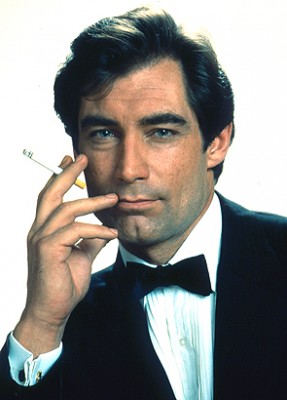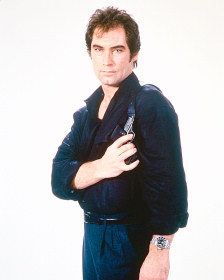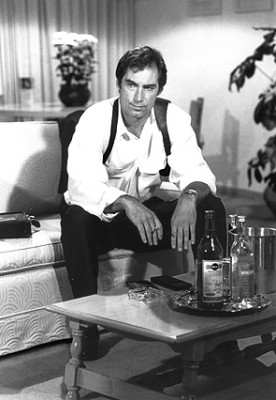
Experience suggests that it is often fun to speculate on ‘alternative’ versions of the Bond universe and explore how the films may have gone in another direction had circumstances been different. Back in 2012, a new book came on to the market about Timothy Dalton’s first James Bond movie, and it was at that time that we felt it was a good moment for the JBIFC to look back at the screen treatment for the film that was never made: a third Dalton 007 adventure.
Charles Helfenstein, the author of the superb book The Making of On Her Majesty’s Secret Service (2009), had recently published a second book entitled The Making of The Living Daylights, which went on sale in October, 2012. As with his first book, it was another very high quality exploration of how a James Bond movie is planned, made and marketed, and offered some fascinating insights, rare anecdotes, and excellent glimpses of storyboards.
At one point in his book, Helfenstein touched upon the film that came close to being made but never was: a third Timothy Dalton 007 adventure. The JBIFC decided to trawl its archives to resurrect some details about the ‘Bond 17’ outline that was actually put together during the planning stages for the proposed movie, and published a blog on this intriguing treatment. Given that the EON franchise has reached another watershed moment in its history, with speculation already mounting about the possible nature of Bond 26 and who will play James Bond, it seems an appropriate moment to republish our original blog on the 007 film that ‘never was’. Enjoy!
Dalton’s Third 007 Adventure
Yes, it nearly did happen. As we know, Timothy Dalton made two Bond movies and was all set for a third, but then complex legal wrangles halted pre-production on Bond 17. After waiting patiently for five years for MGM/UA to sort out the various legal battles, in the spring of 1994 Dalton announced he was leaving the role of 007.
“Bond removes his parachute harness and turns to find the decidedly unpleasant barrel of a pistol thrust against his temple. Mi Wai tells him to keep his hands in sight as she speaks rapidly into a small hand held radio. In a few moments Bond hears the distinctive beat of a helicopter… Mi Wai prods Bond forward… he sees the insignia of the Chinese Red Army on the side of the helicopter”.
The above extract, at first glance, looks like something out of Colonel Sun but comes from the screen treatment that nearly became the basis for the third Tim Dalton Bond movie in 1990/91 – had it gone ahead. In fact, not many fans realize how advanced the plans were for Bond 17 in 1989-90. Moreover, all the evidence suggests that Dalton’s third Bond movie would have placed Fleming’s ‘blunt instrument’ (as grittily played by Dalton) in a much more ambitious and visionary story which had an element of sci-fi at its heart.
An outline treatment by Michael G. Wilson and Alfonse Ruggiero was completed in May, 1990, and, although it was not a full script, it contained a detailed outline story, with descriptions of locations, key characters and major plot concepts. As envisaged in 1990, Dalton’s third would-be Bond movie would have entailed the Bond series continuing to move in the notably realistic direction set out in Licence to Kill, but also brimming with ambitious hi-tech concepts. Wilson and Ruggiero penned an outline which used robotic designs, microchips and advanced electronic apparatus to provide the film with a markedly scientific backdrop. At the beginning of the treatment there was an intriguing preface saying that the ‘robotic devices’ referred to in the outline were ‘complex and exotic machines designed for specific tasks’ and they would be designed ‘especially for the film for maximum and dramatic and visual impact’.
The opening sequence was set in a chemical weapons laboratory in Scotland, and involved technicians performing tests with robotic devices. Suddenly, one of the robotic machines would run amok and the building would explode. After a ‘bitter debate’ in the House of Commons, the Prime Minister would be seen being questioned by MPs about the explosion, and he would assure the House that the ‘full resources’ of the government were being used to investigate the incident.

Enter 007, who, in the treatment, is summoned to MI6’s HQ and to M’s office for the traditional briefing about his mission. There followed a storyline which took Bond to Hong Kong, Japan and mainland China, with the main villain being Sir Henry Lee Ching, described in the treatment as ‘a brilliant and handsome thirty year old British-Chinese entrepreneur’ who, in the traditional Bond sense, is a dab hand at science and electronic circuits, and is also nicely demented. Sir Henry has a habit of arranging ‘accidents’ at nuclear plants, and demonstrates this by having a robotic device run amok at a Chinese atomic plant in Nanking.
The main point to Wilson and Ruggiero’s treatment for Bond 17 was that Sir Henry wanted Britain to withdraw from Hong Kong (remember, this was 1990, some years before the UK actually did hand over the colony). With his expertise in electronics, Sir Henry threatened to unleash a computer virus that would paralyse every military and commercial unit in the world. The climax of the treatment involved James Bond being led to Sir Henry’s base of operations through the sewer system under Hong Kong, with 007 gaining access to the building via a waste-pipe. There followed a classic confrontation between Bond and Sir Henry, with the latter eventually killed when 007 turns a welding torch in his face!
Whether this treatment for Dalton’s third Bond movie sowed some of the seeds for later ideas for the Pierce Brosnan films is difficult to say, but the 1990/91 Bond 17 treatment gives us an intriguing glimpse of the film that might have been.
Bondnote
Since the JBIFC’s original blog on this interesting screen treatment for ‘what might have been’, there have been a number of other short pieces and writings in subsequent years on this ‘third’ Dalton Bond adventure, the most prominent of which was The Lost Adventures of James Bond, by Mark Edlitz (2020). And to add another dimension to the mix, Edlitz also pointed to the existence of a ‘fourth’ Dalton Bond story.

Timothy Dalton in ‘Licence to Kill’. For many fans at the time, Dalton came very close to capturing the essence of Ian Fleming’s creation.
